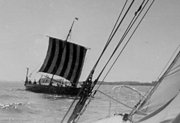Longship
|
|
Oseberg_longship.png
Longships, langskip or drakkar were boats used by the Scandinavians and Saxons for mostly military purposes. They were the epitome of Scandinavian power and high in their admiration of material possessions.
The longship was always of a one-level construction, with oars along almost entire length of both sides, later sporting a rectangular sail on a single mast. Nearly all longships were clinker built and waterproofed by moss drenched in tar. The ship's light mass (compared to knarrs) and shallow design allowed navigation in waters of just 1 meter depth, a rapid deployment on sandy shores in case of a raid and nonetheless hand carriage between river arms or lakes.
Our best evidence for longship construction comes from ship-burials. It was common in Viking society for kings to be buried under a long burial mound in a ship with rich possessions. The Oseberg ship burial in Norway and the Anglo Saxon longship of Sutton Hoo in England are both good examples.
Longships really were long, and narrow - quite extremely so. The largest discovered longship (at Roskilde harbor) is 35m in length, and the longship from Hedeby harbour has the largest length/width proportion: 11.4 to 1. However, later longships, more optimized for sailing, had lower ratios, often 1 to 7 or even 1 to 5.
In contrast, Scandinavian trade ships or knarrs were generally deeper and broader, and more reliant on sails. A similar relationship may be seen in Mediterranean galleys, which are sometimes called longships as well, and their merchant vessels, which were roundships.
The first longships used only oars. In general, the Norwegian and Danish longships were sailed, while no sailing longship has been found from Sweden, only rowing ships, a type less effective for over seas piracy and raidings.
Rectangular sails made of wool strengthened by leather were introduced later. Under sail, longships were very fast, achieving speeds of 14 knots. They were also very seaworthy, but, being essentially open boats, not very habitable. Yet a Scandinavian drakkar was the first European vessel to reach the shores of North America.
The Insular Celtic word for "ship", Old Irish long, Welsh llong is commonly assumed to be a loan from a term for these ships that the British population would have encountered during the Viking Age, such as Latin (navis) longa (see IEW p. 197). McCone (1993) however suggests that *longā is a genuine celtic word for "vessel", based on Gaulish epigraphical LOKAN (possibly "urn"), and the apparently common Insular Celtic *longestā (loinges, llynges) "fleet".
| Contents |
Famous long ships
- The Ormen Lange was the most famous long ship of Olaf Tryggvason
- The Mora was the ship given to William the Conqueror by his wife, Matilda, and used as the flag ship in the conquest of England
See also
External link
- The Ormen Friske disaster – a warning against construction errors in Viking ship replicas (http://w1.570.telia.com/~u57013916/)
- The Viking Ship Museum in Roskilde (http://www.vikingeskibsmuseet.dk)
- The Viking Ship Museum in Oslo (http://www.khm.uio.no/english/viking_ship_museum/index.shtml)
- Vikingships and traditional norse wooden boats (http://home.online.no/~joeolavl/viking/index.htm)
- Heritage Hjemkomst Interpretive Center in Moorhead, Minnesota (http://www.hjemkomst-center.com/)
References
- Kim McCone, Zisalpinisch-gallisch uenia und lokan in Festschrift Untermann, ed Heidermans et al., Innsbruck, 1993.

